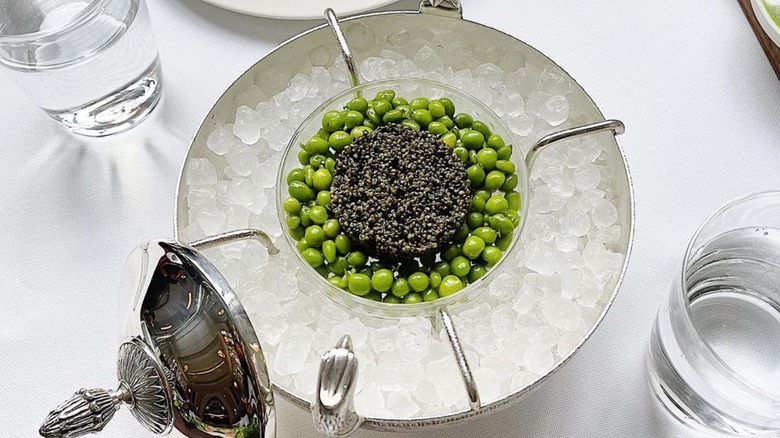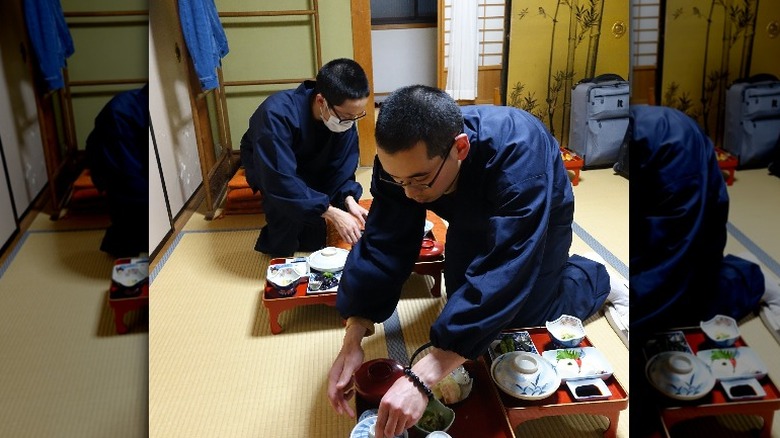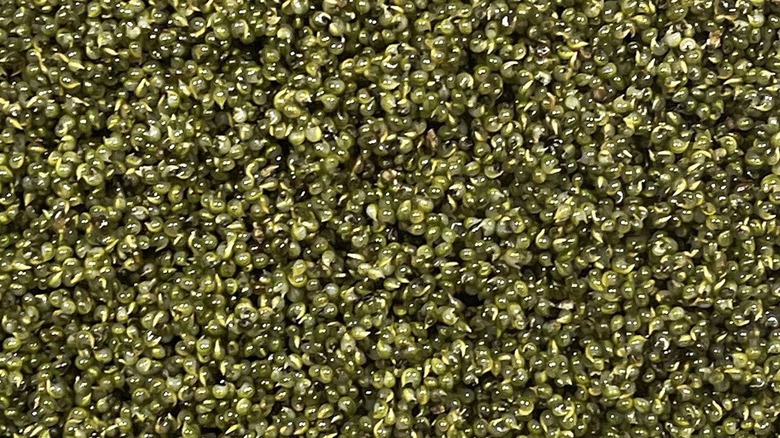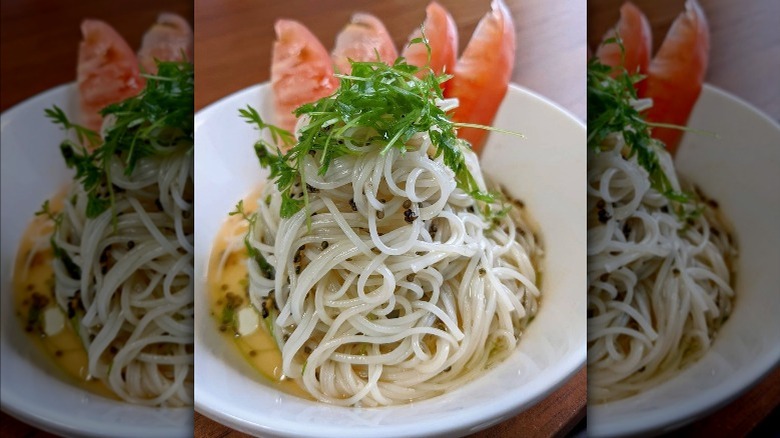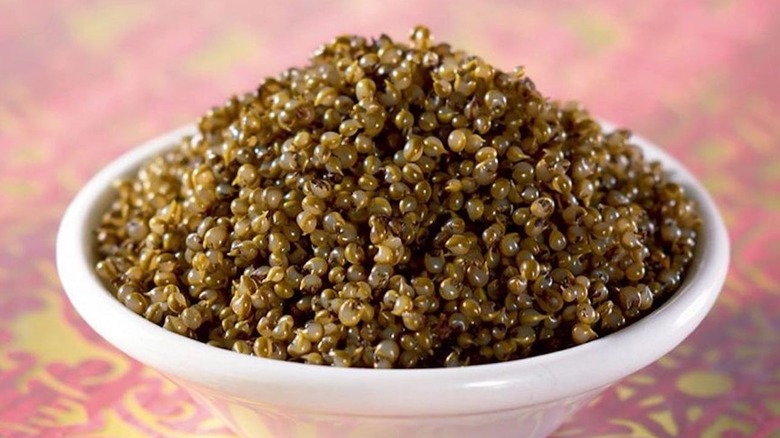What Is Vegan Caviar And Does It Taste Like The Real Thing?
Vegan food options are no longer hidden away in the dark corner of a patchouli-smelling grocery store anymore. Plant-based diets are trending, and animal-free foods are now available at many retailers, restaurants, and even fast-food joints. Vegetarian nuggets, milk, hot dogs, dressings, desserts, and dips abound, but sometimes vegans just can't choke down another Impossible Burger and instead crave an upscale plant-based dish. Nothing says fancy like caviar, and now herbivores can enjoy all the flavor and essential pop of tonburi, aka "land caviar," without compromising any seafood in the process.
Axios highlights the trend of taking plant-based foods to a new upscale level by recounting customers' surprise when Eleven Madison Park in New York reopened in 2021 with a fully vegan menu. The chef of the Michelin star-awarded restaurant, Daniel Humm, said, "It is time to redefine luxury as an experience that serves a higher purpose and maintains a genuine connection to the community." Fine dining is usually synonymous with fish and animal proteins like lobster and Kobe beef, but as plant-based diets become more popular, restaurateurs are starting to invest in flavor over food source.
Tonburi are the seeds of the summer cypress plant
The summer cypress, formerly known as Kochia scoparia, is a rounded shrub that was recategorized into the genus Bassia (per Britannica). It's a member of the Amaranthaceae family that claims around 70 other plants, like buckwheat, grown for their edible seeds. This bisexual annual plant is considered an herb or subshrub that has delicate hair-like leaves that earned it the surname scoparia, which means "broom" in Latin (per NC State Extension).
It produces achenes, which are dry fruits that contain a single seed. Originally native to Asia and Europe, the summer cypress can now be found in North America, according to Minnesota Wildflowers. It blooms from July to October, and autumn turns this shrub from green to deep red, and finally to brown where it resembles a tumbleweed. Dubbed "Mexican fireweed" or "burning bush" for its vibrant red color, summer cypress is mainly used as an ornamental and anti-erosion plant.
Although the summer cypress plant has a delicate and fluffy appearance, it is a surprisingly hardy drought and salt-resistant plant. Farmers view it as a troublesome weed that harbors pests and is unaffected by pesticides, and some varieties in this genus are known to be toxic to grazing wildlife if consumed in large quantities. Its seeds are covered in a husk and enclosed in a dry fruit "shell" that changes color from green to brown as it matures. The small edible seeds are oval-shaped and dark brown to black. The Original Garden notes that summer cypress seeds called "tonburi" are considered an essential ingredient in many Japanese dishes.
Tonburi's history and harvest process
Savor Japan defines Shojin-ryori as "the traditional dining style of Buddhist monks in Japan" following plant-based guidelines. Meals are based on seasonal vegetables, plants found in mountainous regions, and ingredients like tofu that are believed to bring harmony and balance through diet. As Zen Buddhism grew in popularity, so did the monk's take on vegan cuisine harvested locally and seasonally, as seen when Buddhist nun, Jeong Kwan, was a featured chef on Netflix's "Chef's Table" in Season 4. Many favorite vegan ingredients are credited to the Buddhist monks living in the Akita Prefecture region of Japan. In an Instagram post, Chef Daniel Humm of Eleven Madison Park described tonburi as an "essential ingredient of the Akita Buddhist Shojin-ryori cuisine," which he learned about during a collaboration with Japanese friends.
According to Google Arts and Culture, residents from Odate City in the Akita Prefecture of Japan have been processing tonburi for commercial consumption since 1975. Using methods set forth by their predecessors, tonburi processors harvest summer cypress seeds in the fall and bring the plants indoors to keep reaping their seeds year-round. They remove the seeds from the plant's fruit, boil them, machine peel to remove husks, drain the seeds, and then rinse them with fresh water many times over. After removing any red-colored tonburi or other impurities, the end result is a plump, brownish-green seed that resembles cooked quinoa.
The flavor profile of land caviar
Eater notes that chefs are always cautious when profiling the flavor of any vegetarian food. They are tasked with finding a balance between comparing plant-based ingredients to animal products and referencing non-vegan foods so that a new dish is recognizable to patrons. While tonburi has the right texture (gotta have that pop) and mouthfeel of caviar, it has a "vegetal" flavor that is not reminiscent of fish caviar's salty, unctuous taste.
Wild Food Girl attributes the taste of artichoke and broccoli with tonburi that has the same "slippery and crunchy texture of caviar." Many critics of tonburi feel that the texture of the vegan caviar is the only element reminiscent of the fancy fish egg garnish. One critic for Eater even goes so far as to call tonburi flavorless, which may appeal to chefs looking to highlight other flavors through the seeds, but might disappoint diners expecting all the salty goodness of traditional caviar.
How to serve tonburi
After going through the tedious process of harvesting, boiling, and rinsing summer cypress seeds, they are ready to be used in many dishes. The mild flavor of tonburi makes it an ideal blank canvas to showcase other flavors, and its crunchy pop allows it to stand alone as a textural garnish. According to Food in Japan, tonburi is a favorite garnish to many traditional Japanese dishes like udon noodles, kani salad, or as an addition to Japanese mayonnaise. Purveyor of tonburi seeds, Bien Manger, suggests pairing tonburi with smoked fish and creamy sauces or using it as a garnish on blinis, sashimi, and tofu.
Tonburi's mild flavor soaks up the umami boldness of ingredients like soy sauce and miso and is ideally seasoned with intense flavors just before serving. While tonburi is mainly used as a garnish, a few chefs today are making it the feature of their dishes and plating it with blinis and vegan crème fraîche like traditional caviar service (via Eater).
Where can you get tonburi?
If you are ready to make a horticultural commitment, growing a summer cypress bush of your own is easy to do as this self-seeding bush grows like a weed and doesn't need much tending (per NC State Extension). Resistant to harsh elements, the burning bush likes full sun and well-drained soil. Although it hails from Japan, Wild Food Girl says that it grows well in Colorado and other areas of North America. It creates enough seeds, harvested in late summer through the fall, to keep her kitchen well-stocked with tonburi for any occasion. If you plan to grow summer cypress plants to make your own tonburi, prepare yourself for the tedious process of boiling, hulling, and rinsing the seeds to get the final product. Summer cypress seeds can be purchased on Amazon, Etsy, and with other sellers like Seed Corner.
If you want to try tonburi before turning your kitchen into a seed processing plant or can't swing by the Akita Prefecture region of Japan, many online retailers sell the processed seeds. Purveyors like Umami Mart, Rare Tea Cellar, and Bien Manger sell packaged tonburi with prices ranging from $20 to $35. Most sites recommend reconstituting the seeds in a flavorful liquid and draining them before serving.
Health benefits of tonburi
According to Food in Japan, tonburi has been lauded as a "superfood" in Japan for a millennium and is thought to have many health benefits. Tonburi is a high-fiber low-calorie seed that can help balance metabolism by suppressing appetite. These tiny seeds are packed with saponins, which SFGate defines as chemical compounds with antibacterial properties that help fight a range of issues. Saponins might reduce cholesterol levels, improve cardiovascular health, and boost immunity.
Land caviar is a tasty addition to a healthy diet plan, one that has a history of benefits as a superfood and a unique garnish to a multitude of dishes. Although it has been nicknamed as a "caviar" to make it more approachable to unfamiliar diners, the only similarities between tonburi and its seafood counterpart are in their texture. As demand for elevated vegan ingredients grows, the visual appeal, health properties, and unique flavor profile of the tonburi seed will eventually allow it to stand alone.
